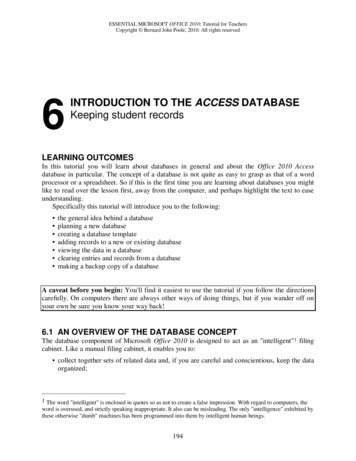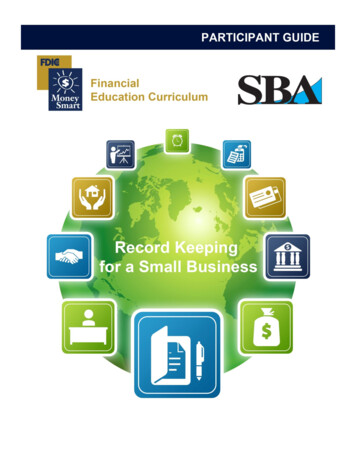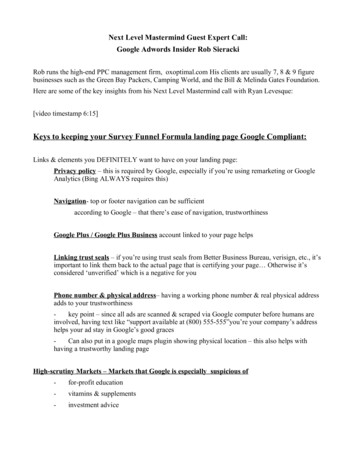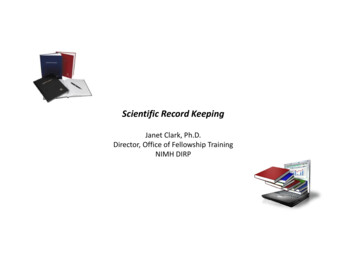
Transcription
ESSENTIAL MICROSOFT OFFICE 2010: Tutorial for TeachersCopyright Bernard John Poole, 2010. All rights reserved6INTRODUCTION TO THE ACCESS DATABASEKeeping student recordsLEARNING OUTCOMESIn this tutorial you will learn about databases in general and about the Office 2010 Accessdatabase in particular. The concept of a database is not quite as easy to grasp as that of a wordprocessor or a spreadsheet. So if this is the first time you are learning about databases you mightlike to read over the lesson first, away from the computer, and perhaps highlight the text to easeunderstanding.Specifically this tutorial will introduce you to the following: the general idea behind a databaseplanning a new databasecreating a database templateadding records to a new or existing databaseviewing the data in a databaseclearing entries and records from a databasemaking a backup copy of a databaseA caveat before you begin: You'll find it easiest to use the tutorial if you follow the directionscarefully. On computers there are always other ways of doing things, but if you wander off onyour own be sure you know your way back!6.1 AN OVERVIEW OF THE DATABASE CONCEPTThe database component of Microsoft Office 2010 is designed to act as an "intelligent"1 filingcabinet. Like a manual filing cabinet, it enables you to: collect together sets of related data and, if you are careful and conscientious, keep the dataorganized;1 The word "intelligent" is enclosed in quotes so as not to create a false impression. With regard to computers, theword is overused, and strictly speaking inappropriate. It also can be misleading. The only "intelligence" exhibited bythese otherwise "dumb" machines has been programmed into them by intelligent human beings.194
Lesson 6: Introduction to the Access Database update the data once you've collected them, adding or deleting records, or changing thecontents of existing records;A database, however, is an electronic filing cabinet which makes it easy for you to quickly workwith the data—sort them, create reports, merge the data with other documents, and so forth.How is a database organized?Access is an object-oriented relational database management system. Access is designed to helpan organization such as a company or an institution such as a school or school district, or even anindividual teacher, collect, organize, manage, and access data in such a way that it can be easilyaccessed and made available to users in a variety of useful ways.The database objects that you can create using Access are listed in Access Objects menu inthe left hand frame of the database illustrated in Fig. 6.1. Let’s take a look at each of theseobjects now to see how they can be used to help you organize and access the informationcollected into a database (in this case a database of information about different birds).Fig. 6.1 The Access database objects A Table is the fundamental object in a relational database and tables use rows and columnsto present the data—rather like a spreadsheet. For this reason, when you view the data as atable in an Access database, you are in what Access calls a Datasheet View. You will learnabout Tables and Datasheets in this lesson, as well as how to use the Design View to createa table, add fields to a table, and define the type of data that is in a specific field. A Form gives the user another way of looking at the data in the database. Whereas a Tableallows the user to view many records at once, a Form displays the contents of just onerecord at a time. Forms are very useful for entering data into new records or updating thedata in existing records. You will learn about Forms in this lesson, too. A Report is used to present a selected set of information from a database in a format that isneatly laid out and thus easier for the user to mentally digest. You will learn about reportsin Lesson 7.195
ESSENTIAL MICROSOFT OFFICE 2010: Tutorial for TeachersCopyright Bernard John Poole, 2010. All rights reserved A Query makes a request to the database, asking it to find some specific data that arestored in the database. You will learn about queries in Lesson 7, too.The general terminology used to describe data storageWords are our stepping stones to knowledge. For the most part, personal computers today stilluse electronic disks and drives of one sort or another to store data. The Windows computeroperating system, like other operating systems, organizes data hierarchically on the disk usingdocuments or files which are usually stored in directories or subdirectories that are part of theoverall directory file management system.Within documents, different terminology is used to describe the organization of datadepending on the type of document in question. Word processed documents organize the data (mostly text) in paragraphs and sentences; Spreadsheet documents organize the data (mostly numbers) in rows and columns; Databases organize the data (of all kinds) into records and fields.Access database terminologyAn Access database is able to contain thousands, hundreds of thousands, even millions ofrecords, depending on the purpose for which the database has been designed. A teacher mayhave dozens of records in his or her class databases; a school district may well have hundreds orthousands of records to collect and maintain; a company like IBM will have hundreds ofthousands of records, maybe even millions of records in multiple databases containinginformation about employees and other kinds of data; a US government office, such as the IRS,will surely have databases with millions of records.Maintaining masses of data such as this is hard. Actually, maintaining even small amounts ofdata is hard, so it’s not surprising that the computer has been brought to the rescue of those of uswho want to manage data.To avoid a hodge-podge of data organized at random, people have come up with the idea oforganizing data into records. Records contain fields. Each field contains entries made up of textand numbers, which are the basic building blocks of data.For example, let us say you have given a student an assignment to study birds and to build adatabase to store the data collected. The student decides to set up a record for each bird sighted.Each record will include several field names, such as Common Name of the bird, Type(Family) of the bird, Size of the bird, Habitat, etc. A field name such as Common Name, forexample, might contain the entry "Seagull" or “Red Ibis.”A database thus contains records; records have fields; the fields contain entries. These entriesare made accessible by the Data View (Table), Form, and Report functions of the Accessdatabase. At the end of a school year, for example, a student would be able to use the wordprocessor (Word) to write a relatively sophisticated paper, and merge into the paper some of thedata collected in the database of Birds information. The student might well also add illustrationsof the birds.6.2 LET’S GET PRACTICALIt will be useful for you at this stage to see an actual Access database on the computer.Make sure you have your Work Files for Office 2010 available on yourcomputer, then open Access (Start All Programs Microsoft Office Access 2010)196
Lesson 6: Introduction to the Access DatabaseIn the File menu select OpenAccess will display the Open dialog box (Fig. 6.2).Fig. 6.2 File menuLocate the Work Files for Office 2010 folder on your disk and open it, thenopen the Access Files folder (Fig. 6.2 above)The database document named Birds should be listed in the dialog box, sodouble click on it to Open itAccess displays a dialog box asking you to decide how you want to view the data in the databaseon the screen. It’s likely that you’ll see a Security warning there (Fig. 6.3), indicating that“Certain content in the database has been disabled.”Fig. 6.3 Security warningIt’s a standard security warning from Microsoft to alert you to the fact that the database does notcontain a digital signature validating its authenticity. You needn’t be alarmed about this withregard to the Birds database we’ll be working with, but it is good for you to know that Microsoft197
ESSENTIAL MICROSOFT OFFICE 2010: Tutorial for TeachersCopyright Bernard John Poole, 2010. All rights reservedis watching out for you to protect your computer from infiltration by viruses and so forth. Youcan remove that warning for now.Next to the Security warning, click on the Options button, then click in theradio button next to Enable this content and click on OKEach of the Access Objects listed in the menu on the left side of the database window (Fig. 6.4)represents one of the possible ways to view the data in the Birds database.These are the two objects currentlyin the Birds database (one Tableand one Form)Fig. 6.4 How do you want to view the data in the database?You can view the data as a form, record by record, as illustrated in Fig. 6.5.Fig. 6.5 The Form View of the database198
Lesson 6: Introduction to the Access DatabaseThis Forms view lets you review the records one by one. You use the tools in the lower leftcorner of the Forms window to toggle from one record to another in the database. On the otherhand, you can view the data as a Table, where the data for all the records in the database aredisplayed in columns or as a list (Fig. 6.6).Fig. 6.6 Records listed in Table ViewLet’s use the Table view now to look at different sets of data in the Birds database.If you didn’t already do so, double click on the BirdSightings table listed inthe Tables Objects in the left frame of the Birds database window (see Fig.6.6 above)In the upper left corner of the Table or Form’s window, in the window’s Title bar, you see theTable or Form name—BirdSightings (Fig. 6.6 above). In the lower left area of the Form andTable window are tools to toggle through and access specific records in the database.Fig. 6.7 illustrates what each of these navigation tools does (Fig. 6.6 above).Fig. 6.7 Navigation tools in the Access databaseThere are 50 records in the Birds database. The field names (Common Name, Family, Size, etc.)are at the top of each column of data. As you can see, the screen is not big enough to allow yousimultaneously to see all the records in the database. If you want to scroll through the records orlook at any specific record, you have several options.You can use the scroll bar on the right of the screen to scroll through the records.199
ESSENTIAL MICROSOFT OFFICE 2010: Tutorial for TeachersCopyright Bernard John Poole, 2010. All rights reservedTry this nowTo move one by one through the records, you can click left or right on the arrows in thenavigation tools in the lower left corner of the window.Try this nowTo go directly to a specific record, you can select the number of the record you want to view bytyping the number of that record in the small data entry box between the arrows (Fig. 6.7).Try this now to select record 12In the Home Ribbon, you can use Go To tool in the Find Group and go to either the First,Previous, Next, or Last record, or you can opt to create a New record.Try this now6.3 PLANNING A NEW DATABASESo much for the nuts and bolts of databases. You are now ready to get your feet wet planningyour own database of student records.Click on the File menu and select Close Database to close the Birdsdatabase, then click on the File menu again and click on the Exit button atthe bottom of the pop up File menuIt will be good for you to start from scratch for the next database exercise. Before you develop anew Access database, you need to have made up your mind where you are going to save the newdatabase (which disk drive are you going to use—your hard disk drive or an external drive suchas a USB Flash drive or Thumb drive, for example. Make sure you know where you are going tosave the new database before you proceed. If you are completing this exercise in a computer labat your school, your instructor will advise you what to do.There are three rules of database design:Rule 1—Plan; Rule 2—Plan; Rule 3—Plan!The more complex the data, the more you need to plan. But even the simplest database should bethought through on paper before being created in Access. Poor planning often results in adatabase that fails to meet longer term, overlooked needs.So think about your database ahead of time—and PLAN!!Points to ponder when planning a databaseThe rule of thumb that should guide you, when planning a database, is that it becomesincreasingly difficult to make changes the further along you go in the process of building a newdatabase. If you think about it, this is true of anything you create.Here, then, are some words of wisdom that you should bear in mind when designing adatabase.Taking your time up front saves time later onThe database you create will have a long, useful life if you take time to plan it carefully. Afteryou have decided on the fields to include with each record, and before you create the database,you should still invest time designing layouts for reports. Thinking about reports will cause youto think about what data you plan to put in the database.200
Lesson 6: Introduction to the Access DatabaseTeamwork helpsDuring the planning stage, run your ideas by others who are familiar with the kind of databaseyou have in mind. Network among your friends. Tell them what you have in mind. Ask them toreview your design. You'll be surprised how many valuable ideas they'll come up with that mayhave escaped you if you had relied on your own resources. Another good idea is to involve yourstudents in the design. This will help them learn skills that will benefit them throughout theirlives.Keep fields simpleThe more "atomic" your fields the more flexible will be your database. Atomic here means"reduced to its simplest form." For example, in a database of names and addresses, you wouldkeep each part of the person's name as a separate field. The first name should be stored by itself;the same for the middle name and last name. That way you can sort the names by first or lastname. You can print a listing last name first or first name last, with or without the middle name,and so on. You will have choices. Lumping the whole name under one field limits your options.Design guidelines for a Student Roster databaseYou have to build a database for a Student Roster. Let us say that your planning has helped youdecide the following about the database and its use: The database will be accessible to, and managed by, your students. Each of them will entertheir own data at the beginning of the year. You will advise them that they are not obligedto fill out every field--that it is OK to leave entries blank. Privacy is an important issue towhich our students need to be sensitized. We need to take every opportunity to teach themthat they should exercise control over data about themselves. They must make decisionsabout what is, and is not, privileged information. In a world where, inevitably andincreasingly, personal data will be available to whomever wants to use it, our students mustlearn early on in their lives that they have a responsibility to keep tabs on that data so as toensure, as far as is humanly possible, that they are correct at all times. Managing their ownrecords on the class database will give them valuable experience in dealing with issues ofprivacy. You have drawn up a list of fields (illustrated later in Table 6.1) for each record in thedatabase. Don't start entering them in yet; you still have a couple of things to get clear atthis planning stage. All the fields will be treated as simple text, except the Date of Birth field, which will be ofDate type, and the Brothers and Sisters fields, which will be of Number type. When youdeclare a field as Date type you can later sort the records in the database chronologically,which has its uses. Likewise, if you declare fields as a Number type you can later sort themnumerically. You can also manipulate numeric data mathematically, creating totals,averages, and so forth. In your class you will designate one student per week as the database manager. A schedulewill be drawn up for this purpose at the beginning of the year. As far as possible, anyinteraction with the database, including the teacher's interaction, will be monitored by thatstudent unless this is inappropriate for reasons of privacy. Other students may use thedatabase only when the student manager is present. The database manager will check the database for items of interest (birthdays, etc.) for theweek he or she is in charge, and will interact with the rest of the class to decide how torecognize such items of interest.201
ESSENTIAL MICROSOFT OFFICE 2010: Tutorial for TeachersCopyright Bernard John Poole, 2010. All rights reserved The last activity on the database at the end of each week will be the process of making abackup of the database. This will be necessary because changes to data can occur at anytime (a student has a new brother or sister, for example). This would be done by the studentdatabase manager under the teacher's supervision.You could add other features in an actual working environment. With all this in mind, you areready to create the database which will hold your student records.6.4 SOME HINTS BEFORE CREATING THE DATABASE TEMPLATEYou are going to start a new database of Student Records. You want to save all your personalfiles—word processed files, presentation files, spreadsheet files, or database files in your ownData Files folder (not in the Work Files folder).Open Access (Start All Programs Microsoft Office Access 2010)Click on the File menu and, from the menu, select NewAccess now presents you with the Getting Started with Microsoft Access screen (Fig. 6.8).Title BarSecond, type thename of the newdatabase hereFirst, click on theBrowse button to setup the folder where youwant to save the newdatabaseLast, click on theCreate buttonFig. 6.8 Getting Started with Microsoft AccessLet’s take a moment to check out Fig. 6.8 on the previous page. In the left-hand frame is a list ofFile menu options, with the New option highlighted, plus the names of any databases you mayhave been working with recently. In the center is a set of icons for different templates (recent202
Lesson 6: Introduction to the Access Databasetemplates, sample templates, or templates you may have created yourself). Then, over on thelower right is the data entry box where you type the name for the new Blank Database. This iswhat you need to do now. But first, let’s make it easier for you to see what you’re doing.Double click in the Title Bar at the top of the Microsoft Access window(see Fig. 6.8)—this will enlarge the window to the size of the complete screenBefore you type the name for the new database, you need to locate where you want to save it onyour disk.For the first step, click on the Browse button next to the File Name box (Fig.6.8 previous page)In the File Name dialog box, locate the Work Files for Office 2010 folderand open itNow double click to open the Data Files folder (if you do not see a DataFiles folder there, go ahead and create it now)Inside the Data Files folder you need to create a new folder for the databases you are going tobuild. You’ll recall doing this in earlier lessons when you created a folder for word processeddocuments and then another for spreadsheets. Here are the steps to remind you how to do createa new folder for your databases.Click on the New Folder icon in the File New Database dialog box (Fig. 6.9)and type the folder name DatabasesFirst click on the New Folder iconand call the new folder DatabasesNext, click here and type StudentRecords Template as the name forthe new database, then click on OKFig. 6.9 Creating a new folder for your databasesType Student Records Template as the name for the new database andclick on OKNow you should be back at the Access New database window (Fig. 6.8 on previous page)203
ESSENTIAL MICROSOFT OFFICE 2010: Tutorial for TeachersCopyright Bernard John Poole, 2010. All rights reservedFor the last step, click on the Create button in the lower right corner of thewindow (see again Fig. 6.8 on page 201)Notice that the Table object is selected on the left side of the Access window. A Table is thedefault object in a new Access database. But first you may need to remove the Security Warningas before.If necessary, click on the Options button and click in the radio button nextto Enable this contentNow click on the Create Tab to bring up the Ribbon for creating Templates,Tables, Queries, Forms, Reports and other database items (Fig. 6.10)Fig. 6.10 Create Tab and Ribbon showing the Groups of tools for creating database objectsIn the Tables group, click on Table DesignYou will now see the Table’s Design View dialog box (Fig. 6.11).Select theData Type foreach field inthis columnYou’ll type theField Names inthis columnYou'll enter Field formatinformation down hereFig. 6.11 The Table Design View dialog box204Here you'll findhelpful hints as yougo along
Lesson 6: Introduction to the Access DatabaseOn the screen, Access is waiting for you to begin typing in the field names. The cursor is locatedin the first data entry box in the Field Name column, prompting you to type in a name for yourfirst field. Access field names can be up to 64 characters in length, by the way, more than enoughfor any purposes. Before you enter the field names, however, read what follows.Editing field names Table 6.1 on the next page provides you the complete list of all the fieldnames for this Students Records database. You also can easily change, add or delete fields.Selecting the data type of a field As illustrated in Fig. 6.12 above, after typing in the fieldname in the first column, you’ll need to decide what the field's data type should be in thesecond column. Table 6.1 below has all this information, too.Setting up predefined entries for a field To reduce the likelihood of bad data getting intothe database, you can limit the user's choices when they enter the data for a particular field.For example, when they enter the Gender, you can limit the choices to M or F. In thedatabase you’re building for this tutorial, you'll be pre-defining the City and State fields aswell. The tutorial will explain how to do this as you go along.6.5 CREATING THE DATABASE TEMPLATEEntering field names for the databaseTable 6.1 contains the complete list of field names for the Student Roster database. You'll bereferring to this Table frequently as you work your way through the next several pages, so youmight like to mark this page so you can find it easily when you need to.Type only the Field Names that appear below in the first column of Table 6.1. The secondcolumn tells you what Data Type to choose. The other columns in the table below (Required,Length and Comments columns) are there to help you as you enter each field name and data typeand explain whether data is to be "Required" for that field and what size (in text characters) thefield is allowed to be, along with tips on what to do. The idea here is to help the eventual users ofthe database when they come to enter student data into the fields.Field NameFirst NameMiddle NameLast NameHome ContactNick NameGenderAddress Line 1CityStateZipPhone NumberDate of BirthBrothersSistersPlace in FamilyClubsHobbiesFavorite SportsFavorite SubjectsData 10152010150252200200200200CommentsUse Lookup Wizard to predefine dataUse Lookup Wizard to predefine dataUse Lookup Wizard to predefine dataUse input mask to specify the formatUse input mask to specify the formatUse input mask (Short Date) formatLong IntegerLong IntegerLong IntegerTable 6.1 Template Field Name listing205
ESSENTIAL MICROSOFT OFFICE 2010: Tutorial for TeachersCopyright Bernard John Poole, 2010. All rights reservedIn the first data entry box in the Field Name column, type First Name for thefield name and hit the Tab key to move the cursor over to the Data TypecolumnNotice, in the lower right section of the window, that Access provides help to guide you as youenter the data for each part of each field. Read this help as you go along. In the lower left sectionof the window you can see the Field Properties dialog box (Fig. 6.12).Area to definethe Propertiesfor each FieldFig. 6.12 The Field Properties dialog boxIf you take a look at what it says in Table 6.1 on the previous page, the Length column specifiesthe number of characters required for several of the fields in your database.Check Table 6.1 on the previous page to find out the correct size for theFirst Name fieldNow, look down at the lower left corner of the Access Design window (Fig.6.12), where you can see a list of Field Properties, along with data entryboxes to specify Field Size, Format, and so forthIn the Field Size box type 10 (so as to allow up to 10 characters for the FirstName)For the First Name field, and for several other fields (again check out Table 6.1) you want theuser to definitely fill in an entry—in other words, an entry is required. You don’t want the fieldleft blank. Here’s how you can ensure that this happens in your database.206
Lesson 6: Introduction to the Access DatabaseIn the Field Properties area (Fig. 6.12 on previous page), double click in thedata entry box next to Required in order to toggle (switch) the entry from Noto YesSince you need a First Name, you don't want it to be zero length so, in theField Properties area, make sure the Allow Zero Length entry is set to NoNow go back up and click in the next Field Name box (below the First Namebox) so you can enter the next database field nameEnter the field names Middle Name (10 characters), Last Name (15characters), Home Contact (20 characters), in each case making sure youhave Yes in the Required Field Property and No in the Allow Zero LengthField Property for each of these fieldsNow enter the field name Nick Name (10 characters), but leave No in theRequired Field Property box, since a Nick Name is optionalBefore naming the rest of the fields in the database, click on the File menuand select Save Object As, then, in the dialog box that pops up asking you togive this new table a name, type the name Student Records TableWhen, as now, you attempt to save the table for the first time, you are asked to define a PrimaryKey for the Table. So what is a Primary Key in a database? The purpose of a Primary Key is toenable easy manipulation of the data across multiple tables. If, for example, you were designinga database for an administrative application in the Principal’s or Superintendent’s office, or for asizable company, this would be an important consideration, because your database would belarge, and there would be many ways of looking at the data in the database (called "views" on thedata) represented by different tables. However, this is not something the class teacher needs toworry about, so you won't need a Primary Key for the table you are about to save.Click on No to tell Access you do not want a Primary Key field in thedatabaseYou’ll notice that Access now lists the Student Records Table as one of the objects in the lefthand frame of the database window.Using the Lookup Wizard to specify selected values for a fieldFor the database fields Gender, City, and State (see Table 6.1 on page 204), the values thatshould be entered are predictable. For the Gender, it will be M or F, for example. For the City, itwill be a couple of the towns or cities where your students live. For the State, it will be theabbreviation for the state in which your students live.The next series of steps show you how to specify pre-selected values such as this for a field.In the next Field Name box, enter the field name Gender and hit TabNow click on the down arrow in the Data Type column and select LookupWizard in the drop down listIn the Lookup Wizard dialog box (Fig. 6.13 on next page) click on the radiobutton next to “I will type in the values that I want”, then click on Next 207
ESSENTIAL MICROSOFT OFFICE 2010: Tutorial for TeachersCopyright Bernard John Poole, 2010. All rights reservedFig. 6.13 Opting to enter the values yourselfIn the next Lookup Wizard dialog box (Fig. 6.14), leave the default 1 for thenumber of columns, hit Tab (or click in the data entry box under Col 1) andtype M (for Male)Fig. 6.14 Entering the values for the Gender fieldHit Tab or click in the next data entry box in the Col 1 column, and type F (forFemale), then click on Next to go to the next step in the Wizard208
Lesson 6: Introduction to the Access DatabaseThere’s no need to change the label for the Lookup column (Gender), so clickon Finish in the dialog boxGo back up to the Field Name column and click in the data entry box underGender, type the field name Address Line 1, hit Tab, in the FieldProperties area type 50 for the Field Size and make it a Required fieldNow you need to use the Lookup Wizard to define a set of data if your students all comefrom the same one or two towns, a likely scenario in any school district. If you teach in apublic school in the US, your students also will all live in the same State. So for the Cityand State fields you’ll use the same steps as you did to create the Gender field.Click under Address Line 1, type the field name City, hit Tab, select LookupWizard for the Data Type and follow the same steps as you did for theGender field to enter the names of a couple of local cities or towns—youdecideCreate the State field with the Lookup Wizard Data Type, too, and enter theinitials for your state as the value for the listYou will see later that the city or cities you name, along with the State, automatically will appearas selections when entering data into those fields in the database.Using an input mask to control the format for a fieldYou want to make sure that certain fields have a consistent
Lesson 6: Introduction to the Access Database 197 In the File menu select Open Access will display the Open dialog box (Fig. 6.2). Fig. 6.2 File menu Locate the Work Files for Office 2010 folder on your disk and open it, then open the Access Files folder (Fig. 6.2 above) The database document named Birds should be listed in the dialog box, so double click on it to Open it











